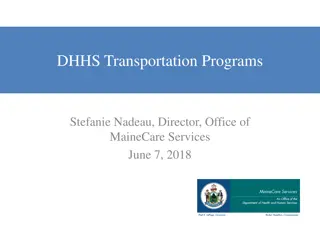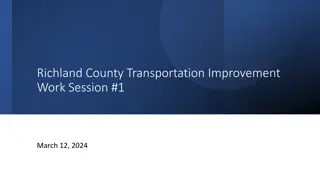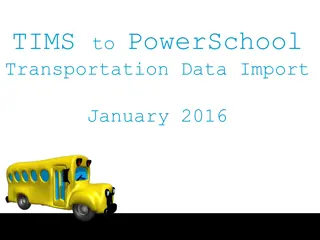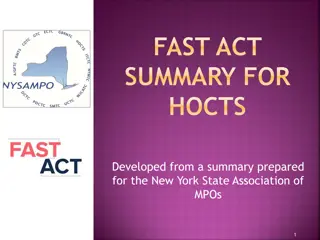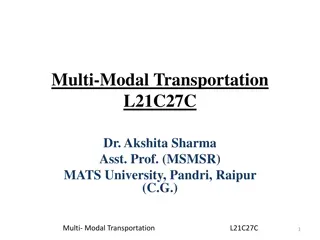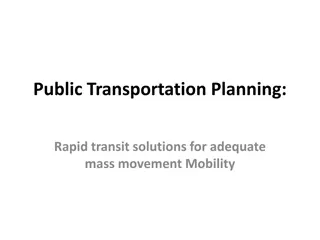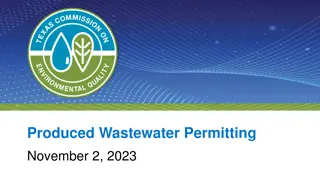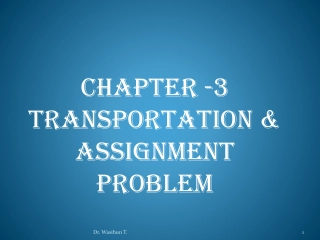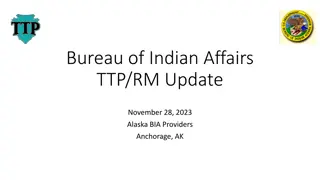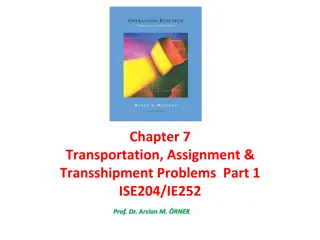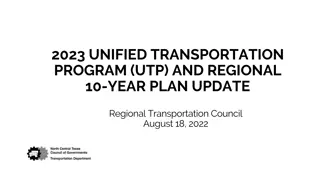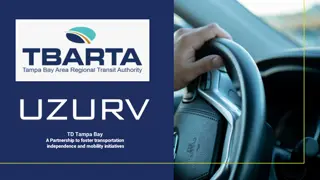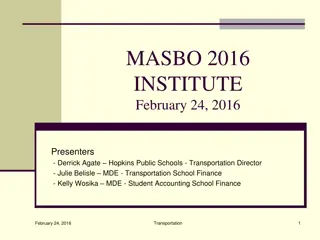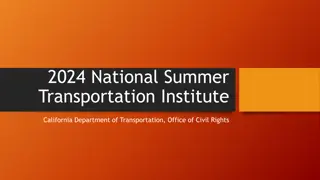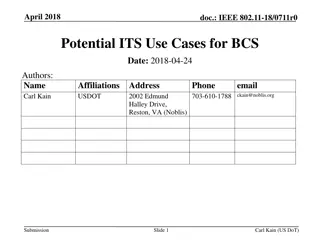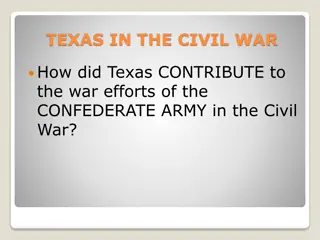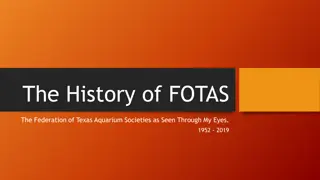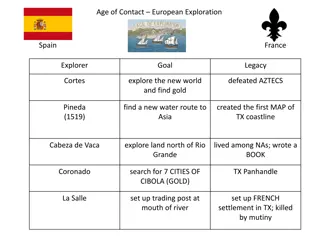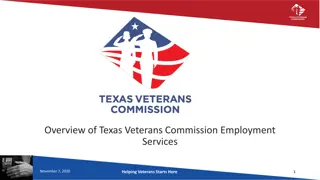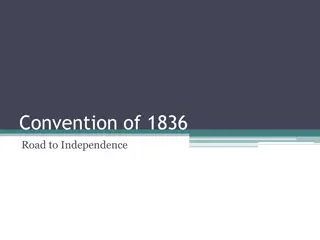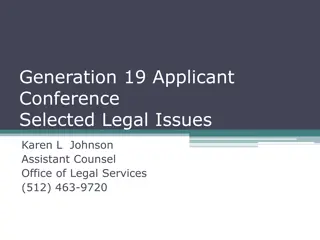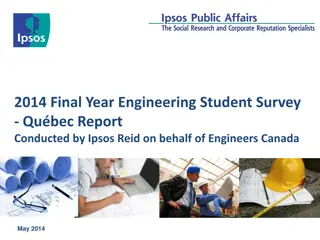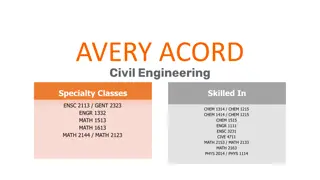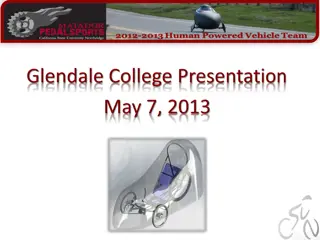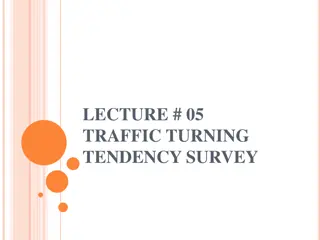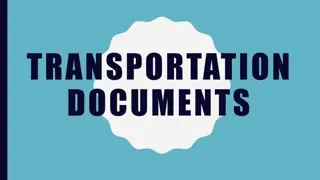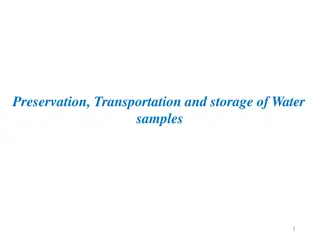Understanding Workcodes in Texas Transportation Engineering
Explore the concept of Workcodes (WC) in the Texas Department of Transportation (TxDOT) engineering framework, which serves as the Texas version of Crash Modification Factors (CMFs). Learn about WC categories, methodology for updating WC, quality checks, pre-selection processes, and examples of WC treatments. Dive into the literature review, data collection, meta-analysis, and comparison techniques involved in enhancing WC tables for improved traffic safety measures.
Download Presentation

Please find below an Image/Link to download the presentation.
The content on the website is provided AS IS for your information and personal use only. It may not be sold, licensed, or shared on other websites without obtaining consent from the author. Download presentation by click this link. If you encounter any issues during the download, it is possible that the publisher has removed the file from their server.
E N D
Presentation Transcript
Updating TxDOT Workcodes Srinivas Reddy Geedipally, PhD, PE Associate Research Engineer, TTI
What are Workcodes (WC)? It s Texas version of CMFs 102 Install STOP Signs Definition: Provide STOP signs where none existed previously. =1 - CMF Reduction Factor (%): 20 Service Life (Years): Maintenance Cost: Preventable Crash: 6 N/A Intersection Related = 1 or 2 =Target crashes
WC categories Code 100 200 300 400 500 Item Signing and Signals Roadside Obstacles and Barriers Resurfacing and Roadway Lighting Pavement Markings Roadway Work
Methodology for Updating WC 1) Comprehensive review of literature Collect CMFs for a specific treatment CMF Clearinghouse Journal papers and project reports 2) Quality check and pre-selection on the Selection of CMFs Soundness of data analysis and methodology Higher star quality in the CMF Clearinghouse Relevance of specific target crash type, severity, and roadway environment 3) Estimate a single value from multiple CMFs Meta-analysis 4) Compare results with the value in the TxDOT WC Table Keep or update the WC Table CMF
Quality Check and Pre-selection Review Lit. and Collect CMFs Meta-Analysis WC within CI Keep WC CMF WC out of CI Update WC CMF Compare with WC A Single CMF with CI * All images from internet
Example Treatment: Converting minor-road STOP to all-way STOP control TxDOT WC: No. 121, CMF = 0.85 (i.e., CRF = 15%) 121 Convert 2-way STOP Signs to 4-way STOP Signs Definition: Provide 4-way STOP signs where 2-way STOP signs existed previously Reduction Factor (%): 15 Service Life (Years): 6 Maintenance Cost: N/A Preventable Crash: Intersection/Intersection Related = 1 or 2 https://ftp.txdot.gov/pub/txdot-info/trf/trafficsafety/engineering/work-codes.pdf
Example Literature Review and Pre-Selection: Study CMF SE Crash Severity Crash Type Roadway Type Angle Lovell and Hauer (1986) 0.25 0.03 All - Stop-controlled intersections Harwood et al. (2000) 0.52 0.04 All All - Stop-controlled intersections - 4-leg intersections - 53 Stop-controlled intersections in NC - 680 to 15,400 AADT Simpson and Hummer (2010) 0.319 0.022 All All
Example Meta-Analysis: 0.52 0.319 ? 2 0.042+ 0.042+ 1 ???????= ?=1 ???? ??? ?=1 1 ??? 0.0222 = = 0.37 ? 2 1 0.0222 1 1 ??? 1 ??(???????) = 2= = 0.02 ? 1 1 ?=1 0.042+ 0.0222 90% Confidence Interval of CMF Low Combined CMF Combined SE High 0.37 0.02 0.34 0.40
Example Compare with WC CMF: WC CMF 0.85 does NOT fall in the CI 0.34 - 0.40 Recommend updating the WC CRF as 63% ( i.e., 1 0.37) Convert 2-way STOP Signs to 4-way STOP Signs Provide 4-way STOP signs where 2-way STOP signs existed previously 15 -> 63 6 N/A Intersection/Intersection Related = 1 or 2 Definition: Reduction Factor (%): Service Life (Years): Maintenance Cost: Preventable Crash:
List of Updated WC - Intersection No. Name of Countermeasure Work Code CMF Single CMF 90% CI Recommended CMF 1 Convert Minor-Road STOP to All-Way STOP Control 0.85 0.37 0.34-0.4 0.37 2 Install "STOP AHEAD" Pavement Markings NA 0.4 0.33-0.47 0.4 3 Install Pedestrian Countdown Timer NA 0.65 0.39-0.91 0.65 4 Install Stop Sign at Highway-Rail Crossing NA 0.68 0.65-0.71 0.68 5 Implement Intersection Conflict Warning Systems on minor approach 0.85 0.73 0.66-0.80 0.73 6 Improve Sight Distance within Sight Triangle NA 0.68 0.53-0.82 0.68 7 Install Transverse Rumble Strips at stop-controlled 0.85 0.77 0.65-0.89 0.85 (No Change) 8 Increase retroreflectivity of STOP signs NA 0.82 0.75-0.89 0.82 9 Install Flashing Beacons at Intersection Approaches 0.65 0.86 0.78-0.94 0.86 10 Install Intersection Lighting at Rural Intersection 0.55 0.87 0.79-0.95 0.87 Implement systemic signing and marking improvement at stop-controlled 11 NA 0.92 0.84-0.94 0.92 intersections Change from Permissive with Circular Green Symbol to Flashing Yellow 12 0.85 0.59 0.47-0.71 0.59 Arrow Signals and Supplemental Traffic Signs 13 Install Left-Turn Lane 0.75 0.77 0.67-0.87 0.75 (No Change) 14 Install Actuated Advance Warning Dilemma Zone Protection System NA 0.89 0.71-1.07 0.89 15 Convert Stop-controlled Intersection into Roundabout 0.6 0.38 0.28-0.48 0.38
List of Updated WC Roadway Departure (partial) No. Name of Countermeasure Work Code CMF Single CMF 90% CI Recommended CMF 1 Centerline Rumble Stripes/Strips 0.65 0.74 0.73 - 0.76 0.74 2 Edgeline Rumble Stripes/Strips 0.50 0.85 0.83 - 0.88 0.85 3 Raised Pavement Markers at Centerline 0.65 0.83 0.78 - 0.88 0.83 4 Raised Pavement Markers at Edgeline 0.40 0.83 0.78 - 0.88 0.83 5 Profile Centerline Markings 0.65 0.93 0.89 - 0.97 0.93 6 Profile Edgeline Markings 0.40 0.93 0.89 - 0.97 0.93 7 Static Curve Warning Sign (Standard) 0.95 0.80 0.33 - 1.27 0.95 (No Change) 8 Enhanced Curve Warning System no comment 0.65 0.62 0.57 - 0.67 0.65 (No Change) 9 Wide Centerline Pavement Markings, 6 NA NA NA NA 10 Wide Edgeline Pavement Markings, 6 NA 0.78 0.65 - 0.91 0.78 11 Install Delineators 0.70 0.88 0.79 - 0.97 0.88 12 Install Surface Mounted Delineators on Centerline 0.65 0.88 0.79 - 0.97 0.88 13 High Friction Surface Treatment, Horizontal curves 0.55 0.48 0.34 - 0.62 0.55 (No Change) 14 Roadway Lighting 0.60 0.54 0.51 - 0.57 0.54 15 Remove or Shield Tree or Fixed Objects 0.50 0.07 0.06 - 0.09 0.07
List of Updated WC Pedestrian (partial) No. Name of Countermeasure Work Code CMF Single CMF 90% CI Recommended CMF 1 Install Pedestrian Signal 0.66 0.87 0.81-0.93 0.87 2 Improve Pedestrian Signal 0.90 3 Install Pedestrian Countdown Timer NA 0.65 0.39-0.91 0.65 4 Install Raised Pedestrian Crosswalks NA 0.54 0.39 - 0.70 0.54 5 Implement Barnes Dance (Diagonal Crossing) NA 0.58 0.30 - 0.86 0.58 6 Install Pedestrian Hybrid Beacon 0.85 0.58 0.30-0.86 0.85 (No Change) "Install Pedestrian Hybrid Beacon (PHB or HAWK) 7 NA 0.43 0.21 - 0.65 0.43 with Advanced Yield or Stop Markings and Signs" 8 Install Pedestrian Crosswalk 0.90 0.55 0.00-2.09 0.90 (No Change) 9 Install High-Visibility Crosswalk NA 0.78 0.26 - 1.30 0.78 10 Median Crossing Island, Refuge Island, Raised Median NA 0.67 NA 0.67 11 Automated Pedestrian Detection NA 0.91 NA 0.91 12 Road Diet NA 0.59 NA 0.59 13 Install Transverse Rumble Strips at Pedestrian Crosswalks NA 0.76 0.22 - 1.30 0.76 14 Speed Humps NA 0.60 0.34 - 0.86 0.60 15 Parallelogram-Shaped Pavement Markings NA 0.79 0.70 - 0.88 0.79
The Context There are multiple potential CMFs to use in the HSIP process The applicable crashes for each WC vary in general
The Challenge S 20 100= 0.80 ????= 1 B A Independence is assumed when CMFs for a crash type in common When the CMFs are independent, they can be multiplied to find the combined effect Consider the diagram of independent WCs: 100 total crashes 20 preventable by WC A 5 preventable by WC B 1 preventable by WC A or B 5 ????= 1 100= 0.95 19 4 1 76 ???? ?= 1 19 + 1 + 4 = 0.76 100 ???? ????= 0.80 0.95 = 0.76 A and B are independent because: ???? ?= ???? ????
S H G 10 15 Non Independent CMFs on a common set of applicable crashes 75 ???? ?= 1 15 + 10 ???? ?= 1 1 + 24 = 0.75 = 0.75 100 100 ???? ????= 0.75 0.76 = 0.57 ???? ????= 0.85 0.90 = 0.765 ???? ???? ???? ? ???? ???? ???? ?
New method of combining CMFs CMF impacts are estimated for each of regions I and II The proposed scheme is applied to region III The overall combined CMF is the weighted average of the three regions I. Crashes only preventable by WC1 III. Crashes preventable by WC1 OR WC2
Combined CMF Determination Identify the range of possible scenarios Between non-independence extremes Independence is on the major diagonal Calculate weighed average of extremes and independent cases Estimate is always more conservative than independence
Example 532 Texturize Shoulders (rolled-in or milled-in) Definition: Reduction Factor (%): Service Life (Years): Maintenance Cost: Preventable Crash: Install milled-in or rolled-in rumble strips along the shoulder. 15 10 N/A (Roadway Related = 2, 3 or 4) OR (Vehicle Movements/Manner of Collision = 30) 542 Centerline Texturing Definition: Reduction Factor (%): 26 Service Life (Years): Maintenance Cost: Preventable Crash: Install milled-in rumble strips along the centerline. 10 N/A (Vehicle Movements/Manner of Collision = 21 or 30) OR (Roadway Related = 2 or 3) Combined CMF = 0.85 x 0.74 = 0.63
CRFs Relative to S or Total Crashes S =applicable crashes either to WC1 or WC2 T = All crashes in facility of interest Range and weighted average of combined CRFs are estimated relative to S and relative to T
THANK YOU Srinivas Reddy Geedipally, Ph.D., P.E. Associate Research Engineer Texas A&M Transportation Institute Srinivas-g@tti.tamu.edu Tel 817.462.0519 ext 11519


